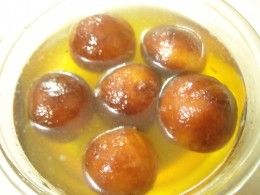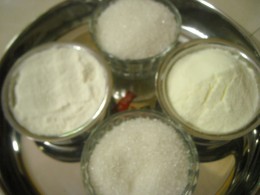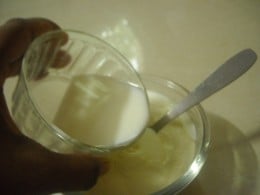Gulab
jamun is a popular dessert of South Asia. Countries such as India,
Nepal, Pakistan, Sri Lanka, Bangladesh are familiar with this dessert.
As it is made in rosewater, the dessert got its name ‘gulab jamun’ in
which ‘gulab’ is derived from Persian meaning rose. The word ‘jamun’
relates to the jamun fruits or java plums grown in Asian countries. The
traditional method of preparing this dessert is from milk solids.


History of gulab jamun
Gulab
Jamun originates from Afghanistan. As it is made in sugar syrup scented
with rose water, it got its first name ‘gulab’. Later saffron was
widely used in place of rose water. Sikhs claim that gulab jamun was
prepared by a Sikh chef named Sajjan Dhillon first to impress the king
of Jaladabad. Some others claim its origin with some other stories. The
dessert also became popular in Turky, during the Ottoman Empire that was
called ‘lokma’ in Arabic language.
Gulab jamun recipe from milk solids
‘Khova/Khoya’
made from milk is what is traditionally used for preparing gulab jamun.
Khova is milk cheese that is obtained by boiling and reducing milk in a
wok for a longer time. You can replace khova with skimmed milk powder
or condensed milk as preparing khova is time consuming.
Cook Time
Prep time: 45 min
Cook time: 20 min
Ready in: 1 hour 5 min
Yields: 10 gulab jamuns

Main ingredients | Source
Ingredients
- 1 small cup refined flour or maida
- 1 small cup skimmed milk powder
- 2 small cups sugar
- 2 small cups water
- 1 tbs baking soda
- a pinch saffron
- 4 to 5 cardamom pods
- 1/2 cup oil or clarified butter
Click thumbnail to view full-size












Instructions
- Make the sugar syrup by boiling water and adding sugar to it. When it dissolves completely, stir it well to get a light solution. Mix powdered cardamom and saffron with it and keep aside covered.
- Next step is preparation of dough. Flour and milk powder have to be kneaded well in a bowl by pouring milk little by little. Baking soda makes the mixture soft. If the mixture is hard, then sprinkle some water and knead well so that soft, small balls can be made out of the mixture.
- Make small balls without forming any cracks and holes. Cracks may lead to disintegration of the balls while frying. Uniformly molded small balls would bring up attractive and appetizing gulab jamuns.
- Fry these balls in a wok of oil or clarified butter on medium flame. You can fry one at a time, but not more than three. Ensure that the balls are fried uniformly and have the brown color. Also frying on high flame may cause break-up of the balls. When done, transfer these balls to the bowl containing sugar syrup.
- After being soaked in the sugar syrup for about 2 to 3 hours, the balls turn to sweet ‘gulab jamuns’.
Rate this recipe please
In
North India, gulab jamun is a common dessert that has a dignified place
in the dining table. As commercial powder for making gulab jamuns is
available now-a-days, making this dessert is very easy. But gulab jamuns
made from khova are the real jamuns whose taste is lingering that can’t
be obtained from using others.
Please vote!
Do you like gulab jamuns?
Nutritional facts for gulab jamuns
| Nutrition Facts | |
|---|---|
| Serving size: 1 ball | |
| Calories | 143 |
| Calories from Fat | 72 |
| % Daily Value * | |
| Fat 8 g | 12% |
| Saturated fat 3 g | 15% |
| Unsaturated fat 5 g | |
| Carbohydrates 17 g | 6% |
| Sugar 16 g | |
| Fiber 0 g | |
| Protein 2 g | 4% |
| Cholesterol 10 mg | 3% |
| * The Percent Daily Values are based on a 2,000 calorie diet, so your values may change depending on your calorie needs. The values here may not be 100% accurate because the recipes have not been professionally evaluated nor have they been evaluated by the U.S. FDA. | |






0 comments:
Post a Comment